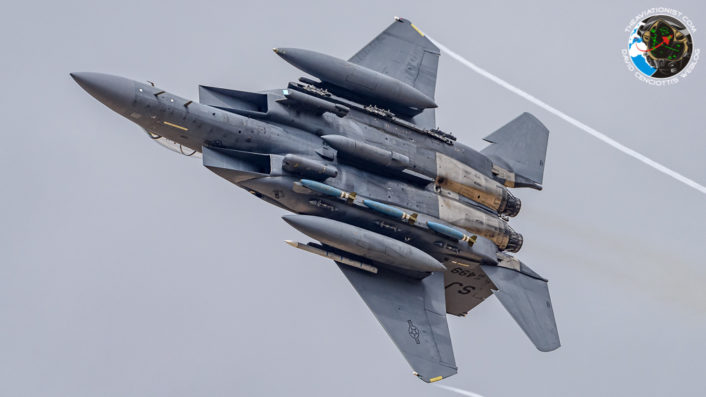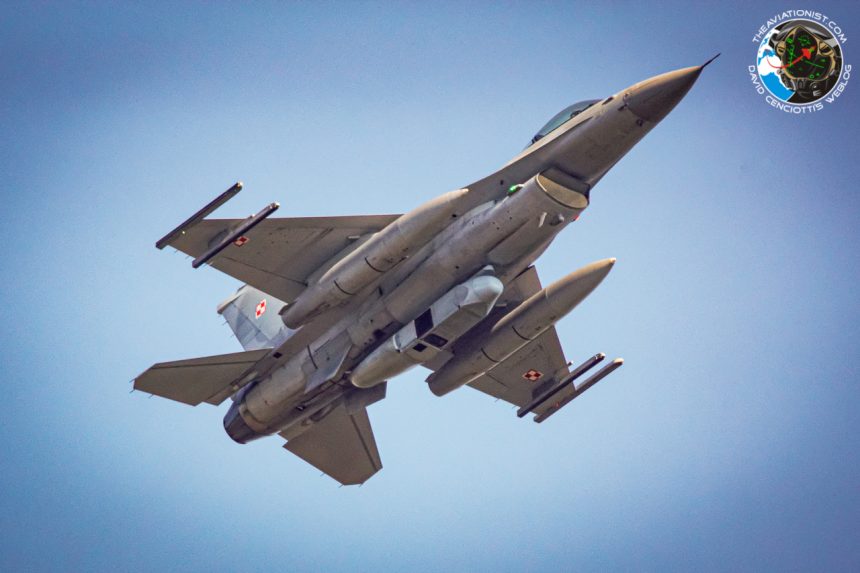Looks like the DB-110 Pod Is not Enough For the Polish Air Force.
The Armament Inspectorate of the Polish Ministry of Defense announced a launch of a procurement procedure, on Oct. 6, 2020, aimed at the acquisition of new aerial reconnaissance assets. The shopping list includes three SAR (Synthetic Aperture Radar) intel-gathering pods. Associated ground equipment is also to be procured: mission planning/pod programming stations and stations for data analysis and transmissions, both ground-based. The procurement in question would also involve integration on the Polish Air Force’s F-16C/D Block 52+ jets. The process is conducted in line with a procedure involving negotiation with potential bidders.
Additionally, a database is going to be acquired for storing all IMINT, SAR imagery, reports, and metadata. Maintenance systems, tools, and ground support equipment would also be procured. Finally, the Ordering Party also wants to procure technical documentation for the new pods. The whole procurement is expected to be finalized in 3 years and 8 months, from the date of agreement.
Polish F-16s are already performing the reconnaissance missions. This refers to the F-16 jets stationed at the Łask AB, near Łódź, in central Poland. Interestingly, when the Polish F-16s were deployed to the Middle East, IMINT was the primary mission they had. So far, the jets have been using the Goodrich DB-110 IMINT pods. As Dziennik Zbrojny’s Tomasz Dmitruk recalls, 7 examples of this system are available, along with ground-based intel analysis assets. The DB-110 is an optoelectronic sensor with a night-vision and thermal imaging cameras onboard. The SAR-based system would be weather- and daytime-independent.
Dmitruk also recalls the fact that the new system was to work in conjunction with the existing DB-110 assets, pointing to a market analysis launched back in July 2017. That process was aimed at verifying whether the SAR recce pod could be acquired and integrated with the DB-110. Most plausibly, as the potential integration probably turned out to be impossible, the current procurement concerns a SAR sensor alone.
Northrop Grumman’s AN/ASQ-236 Dragon’s Eye is one of the possible solutions available here. The system, with a Ku-band AESA, allows for detecting land-based targets. It has already been integrated into the F-16C and F-15E jets. Notably, last year the F-15E Strike Eagles accompanying the F-35s visiting Poland during the Rapid Forge exercise were carrying the AN/ASQ-236 under their belly.

Heated debate
Some questions emerge though when it comes to this purchase. The procurement has also sparked a heated twitter debate among the Polish experts who brought up numerous arguments. First, the Polish F-16 already have a heavy workload imposed on them. The use of SAR recce pods is not really feasible during a conflict in an A2AD setting. Furthermore, the Polish Air Force expects delivery of the 5th generation F-35s. These aircraft feature an impressive sensor suite that could be put into use in the missions involving intel-gathering. Thanks to their low RCS they can also stay closer to the potential adversary, thus the intel they gather would be far more accurate.
Peacetime use is also dubious. A single flight hour for an F-16 is very costly, the platform also has limited endurance and time on station. This task would be more (economically) feasible if assigned to UAVs. Poland seems to have stopped the procurement programs in this area, especially when it comes to MALE assets. No progress, when it comes to the heavier platforms, could have been seen here for a few years now (Zefir program – analytical-conceptual phase since 2013). Small and micro UAVs are being acquired though – Poland has already acquired the mini-UAVs, the Wizjer program is being negotiated, tactical short-range UAVs procurement agreement has already been finalized.
During peacetime, it would be far more cost-effective to use a turboprop platform for that purpose. Here, the Polish MoD had a Płomykówka SIGINT/RADINT platform procurement program in progress, it seems to have come off everybody’s radars. The last news pieces concerning the Płomykówka acquisition date back to late 2017. The process has not been brought to an official closure, nonetheless, it seems to be stuck in the never-ending analytical-conceptual phase. Theoretically, it was scheduled to come to an end this year, according to our source – in practical terms, silence surrounds this acquisition and it seems to have been forgotten.
Still, if the new pod would extend the capabilities of the DB-110, then it could be viewed simply as a complementary asset. Maybe the acquisition is an ad hoc procurement that would meet the requirements related to foreign deployments. Reconnaissance sorties require long flight endurance, and long flight endurance translates into heavy tanker involvement. Hence, the recce taskings could be efficient only when AAR assets are available – and this is typical for allied involvement abroad.
4th – 5th gen. integration
Notably, numerous experts also suggest that most of the scenarios seeing the involvement of the Polish Air Force would also see operations performed by a mix of 4th and 5th generation jets. For Poland the 32 F-35s would not be enough, probably, to meet the demanding requirements of the battlefield, should a potential conflict break out. The Vipers would still do most of the work. Hence, cross-generational integration is most probably going to be the way that Poland is going to go. As one of the leading states procuring the F-35, Poland would also become one of the first nations to carry out the integration of the aforesaid platform mix.
Another acquisition that could fill in the current capability gap in the Polish Air Force would be a purchase of anti-radiation missiles (such as the AARGM – Advanced Anti Radiation Guided Missile – manufactured by Northrop Grumman). Despite the heavy marketing campaign promoting the aforesaid missile in Poland, the MoD, so far, has not made any decisions within that regard. SEAD/DEAD missions are an indispensable element of scenarios happening in the A2/AD setting though. Poland is either waiting for the AARGM-ER to be fully developed (to integrate it on the F-35). The AARGM procurement could come next. Some time ago the rumors suggested that the Warhawks Wild Weasel squadron based in Spangdahlem would be stationed at one of the Polish airbases. However, earlier this year, it has been announced that the 480th Fighter Squadron will be stationed at Aviano AB, Italy.








